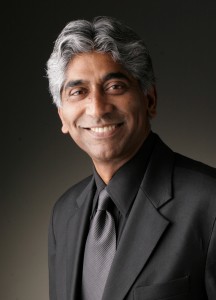World-famous Indian-American film producer Ashok Amritraj challenges 12 promising filmmakers with a shot at worldwide recognition. With a camera in hand and just 24 hours, competitors strive to capture the heart of a complicated global issue.
In partnership with the United Nations and UCLA’s own Ronald W. Burkle Center for International Affairs, Amritraj, the CEO of Hyde Park Entertainment, brings to life his new reality show, “Chance of a Lifetime: Competing for Glory, Fighting for a Cause.” The program will premiere on Participant Media’s new cable channel, Pivot, in two parts on Feb. 15 and 16, followed by a marathon of all seven episodes on Feb. 20 in celebration of the United Nations’ World Day of Social Justice.

(Hyde Park Entertainment, Inc.)
“Even from the starting point, my aim was to create a show that would impact both the younger and older generation to act towards certain social causes and suddenly bring people to think about those serious issues that are generally just provided in the form of a PSA,” said Amritraj.
The show’s premise involves grouping 12 participants, from different countries, into three international teams. In round one, the teams must provide their documentary proposals and are given 24 hours to make a one-minute documentary on their issue. After the participants are whittled down over successive rounds, a final filmmaker will be chosen to show his or her 10-minute documentary to the United Nations and will be recognized at Variety Magazine’s gala event at the Cannes International Film Festival.
“UCLA sort of brought (the show) into proper form and worked very hard with the United Nations and Hyde Park Entertainment to provide a framework and summarize issues, giving it to us in a way documentary filmmakers can understand the root of these causes,” said Amritraj.
Alexandra Lieben, the deputy director at the Burkle Center for International Relations and head researcher for the project, was brought in on behalf of the center’s Global Impact Initiative. The program works selectively to bring entertainment industry professionals in touch with governmental departments and global political leaders. The Burkle Center often partners with the United Nations’ Creative Community Outreach Initiative to provide Hollywood-coordinated visits to U.N. sites.
Lieben said the United Nations aims to support increased and accurate
coverage of urgent global issues and events, making the Burkle Center an
ideal linkage for “Chance of a Lifetime.”
“(The United Nations) had started to work with (Amritraj) on the documentary series, but we have academic resources here,” Lieben said. “(We have) the ability and knowledge to conduct research the United Nations does not. We were an obvious go-to entity for that and that’s when and why we could step in and help with the production.”
Amritraj said the series aims to result in a documentary on topical concerns addressed in the United Nations’ Millennium Development Goals. He said the United Nations’ own film and media outlet, powered by the Creative Community Outreach Initiative, often provides a voice to global issues, but being based in New York, is often left unheard by Hollywood’s entertainment audiences.
“(The show) was about connecting the worlds I’d been involved with … about connecting east and west and bringing diverse cultures together in a way where they can find some kind of partnership,” said Amritraj.
“Chance of a Lifetime” began gestating about a year before it came into existence, employing 10 UCLA student interns to provide research about a given global concern and an idea of the extent to which it has affected certain countries.
Third-year global studies major Natalie Charney was one of the chosen interns for topic research. Collecting stock footage, as well as getting the participating filmmakers in touch with experts in each field, were a few of the given tasks she contributed along the way. Charney said she focused primarily on the availability, accessibility and quality of water around the world.
“My briefing consisted of a two-page introduction, facts and figures, how the United Nations was involved and the future of the issue,” Charney said. “I really think the effort by the U.N. to make people aware through this media outlet via a television show is proactive and inspiring because it meets the general public at a place where they would normally already be – watching TV!”
Amritraj said what he hopes for viewers to gain after watching “Chance of a Lifetime” is a more focused understanding of the causes involved with global problems.
“Often the issues seem so large that you feel like they are too large to deal with,” Amritraj said, “One feels a bit overwhelmed. What we try to do, and what we aim to do, is to not think of it that way. Each individual can make a difference because the result is additive.”
